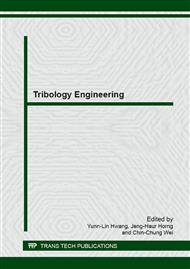p.60
p.66
p.72
p.78
p.84
p.89
p.94
p.99
p.104
Influences of Various Zr Target Current on Tribological Behavior of a-C:H:Zr-x Coatings
Abstract:
A series of a-C:H:Zr-x coatings (the x in the term a-C:H:Zr-x is the Zr target current varied in the deposition process) have been deposited on AISI M2 steel used unbalanced magnetron sputtering system (UBMS). During deposition process, different a-C:H:Zr-x topcoats were deposited by varying the Zr target current from 0.0 A to 0.5A while maintaining the remaining process conditions at the constant settings. The microstructure, adhesion and tribological properties of the a-C:H:Zr-x coatings were found to vary with the Zr content. The tribological properties of the coatings had been tested against AISI 52100 or Si3N4 counterbody under ball-on-disk point contact wear mode using an oscillating friction and wear tester. Of the various coatings, the a-C:H:Zr-0.4 coating provided the best tribological properties, including the lowest wear depth, the friction coefficient and the longest lifetime. Compare to the coatings sliding against both counterbodies, all of coatings possessed the high wear depth as sliding against Si3N4, but it displayed longer wear lifetime than sliding against AISI 52100.
Info:
Periodical:
Pages:
84-88
Citation:
Online since:
April 2015
Authors:
Keywords:
Price:
Сopyright:
© 2015 Trans Tech Publications Ltd. All Rights Reserved
Share:
Citation:


